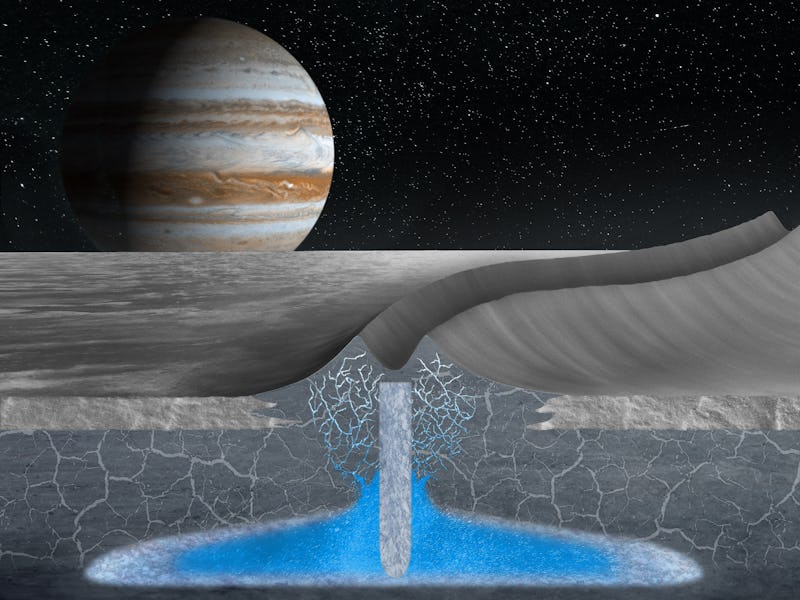How a ridge of ice in Greenland could help us find alien life in Europa’s ocean
Europa, one of Jupiter's four largest moons, is believed to be one of the likeliest places for life beyond Earth.

Oceans may hide beneath the icy surface of Jupiter's moon Europa, leading to hopes they may host alien life as they do in Arthur C. Clarke's Space Odyssey series. Now, in a new study appearing Tuesday in Nature Communications, researchers suggest these seas may lurk closer to Europa's surface than previously thought, making it easier for missions to discover any potential signs of life there.
HERE'S THE BACKGROUND — Data collected by the Voyager and Galileo spacecraft suggested an ocean of liquid water may hide under an ice shell approximately 20 to 30 kilometers thick. However, much remains uncertain about this frozen crust, such as its actual thickness.
Scientists investigated the most common surface feature on Europa — nearly symmetrical pairs of ridges, each flanking a shallow trough, which previous research found across the icy moon. These features can reach hundreds of kilometers long. They discovered a similar double ridge about 800 meters long and 2.1 meters high on the ice sheet in northwest Greenland with the same geometry as those seen on the Jovian moon.
"Scientists have been studying double ridges on Europa for more than 20 years, but this was the first time that we were able to watch something similar happen on Earth and actually observe the subsurface processes that led to the formation of the ridges," study lead author Riley Culberg, a geophysicist at Stanford University, tells Inverse.
This work "is really an example of the value of multidisciplinary teams in science," Culberg notes. "One of my colleagues, who is a planetary scientist, was giving a presentation on the big open questions in Europa science and showed a picture of these double ridges on the surface. It struck me that I had seen a similar looking feature in my own data from Earth while working on a totally different project related to climate change impacts on the Greenland Ice Sheet."
Looking back through the Greenland data together, they found "once we accounted for the difference in gravity between Earth and Europa, these features had very similar shapes," Culberg says. "And fortunately, on Earth we already had all of the data that we needed to now study the processes that had formed this double ridge in Greenland."
Comparison of the two features across two planets.
WHAT DID THEY FIND? — After examining satellite and ice-penetrating radar data of the Greenland double ridge, the researchers suggested it formed through a succession of refreezing, pressurization, and fracture of a shallow pocket of water within the ice sheet. They noted that if a similar phenomenon formed the double ridges on Europa, that might suggest that shallow liquid water is present in the moon's ice shell.
"If the mechanism for double ridge formation that we observed in Greenland also translates to Europa, it suggests that shallow water pockets must have been, or maybe still are, extremely common in the ice shell," Culberg says. "Double ridges are by far the most common surface that we see in imagery from Europa, so shallow water would really have to be everywhere in the ice shell."
Just how shallow do the researchers mean? "In Greenland, the water pocket we studied was less than 30 meters below the surface of the ice," Culberg says. "Given the very different conditions in Europa's ice shell, we think that any potential water pockets would be much larger and deeper than what we observe on Earth, and more likely located one to five kilometers below the surface of the ice shell."
The potential existence of shallow water pockets on Europa is interesting for two reasons. First, any possible exchange of chemicals between this ocean and the surface of the icy shell may be important for life, Culberg says.
"Second, these water pockets might preserve evidence of life in the deeper ocean from which the water was originally sourced, or possibly form smaller habitable environments relatively close to the ice surface," he adds. "If so, it would be much easier for any future space mission to sample such shallow water pockets, rather than attempting to access the subsurface ocean through potentially as much as 20 to 30 kilometers of ice."
The discovery "that liquid water is and has been a pervasive feature in Europa's ice shell is very exciting," Krista Soderlund, a planetary scientist at the University of Texas at Austin who did not take part in this research, tells Inverse. "This not only has implications for the satellite's habitability but also for explaining why its surface looks the way it does." Shallow water may also help explain possible plumes seen on Europa, Soderlund adds.
Greenland ice radar measurements showing what Europa’s ridges may hide.
WHAT'S NEXT — The scientists have a decade's worth of ice-penetrating radar data on Greenland that may prove a treasure trove of insights on Europa and potentially other icy ocean worlds as well. However, Culberg cautions they still need to model how any phenomena seen on Earth may translate to Europa, if at all, given the many differences between the sites in terms of temperature, chemistry, and other features.
The ice-penetrating radar instrument, REASON, on NASA's Europa Clipper spacecraft, planned for launch in 2024, is well-positioned to test this new research, "since it was designed to characterize the distribution of any shallow subsurface water, as well as to investigate processes governing material exchange among the ocean, ice shell, surface, and atmosphere, including plume activity," Soderlund says.